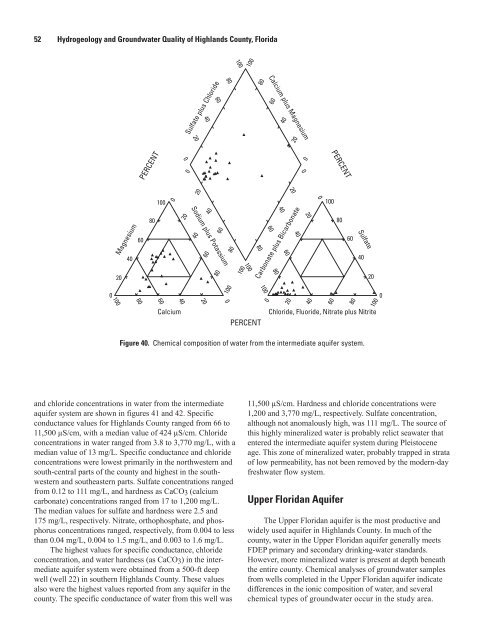Hydrogeology and Groundwater Quality of Highlands ... - USGS
Hydrogeology and Groundwater Quality of Highlands ... - USGS
Hydrogeology and Groundwater Quality of Highlands ... - USGS
Create successful ePaper yourself
Turn your PDF publications into a flip-book with our unique Google optimized e-Paper software.
52 <strong>Hydrogeology</strong> <strong>and</strong> <strong>Groundwater</strong> <strong>Quality</strong> <strong>of</strong> Highl<strong>and</strong>s County, Florida<br />
0<br />
100<br />
20<br />
Magnesium<br />
40<br />
<strong>and</strong> chloride concentrations in water from the intermediate<br />
aquifer system are shown in figures 41 <strong>and</strong> 42. Specific<br />
conductance values for Highl<strong>and</strong>s County ranged from 66 to<br />
11,500 µS/cm, with a median value <strong>of</strong> 424 µS/cm. Chloride<br />
concentrations in water ranged from 3.8 to 3,770 mg/L, with a<br />
median value <strong>of</strong> 13 mg/L. Specific conductance <strong>and</strong> chloride<br />
concentrations were lowest primarily in the northwestern <strong>and</strong><br />
south-central parts <strong>of</strong> the county <strong>and</strong> highest in the southwestern<br />
<strong>and</strong> southeastern parts. Sulfate concentrations ranged<br />
from 0.12 to 111 mg/L, <strong>and</strong> hardness as CaCO3 (calcium<br />
carbonate) concentrations ranged from 17 to 1,200 mg/L.<br />
The median values for sulfate <strong>and</strong> hardness were 2.5 <strong>and</strong><br />
175 mg/L, respectively. Nitrate, orthophosphate, <strong>and</strong> phosphorus<br />
concentrations ranged, respectively, from 0.004 to less<br />
than 0.04 mg/L, 0.004 to 1.5 mg/L, <strong>and</strong> 0.003 to 1.6 mg/L.<br />
The highest values for specific conductance, chloride<br />
concentration, <strong>and</strong> water hardness (as CaCO3) in the intermediate<br />
aquifer system were obtained from a 500-ft deep<br />
well (well 22) in southern Highl<strong>and</strong>s County. These values<br />
also were the highest values reported from any aquifer in the<br />
county. The specific conductance <strong>of</strong> water from this well was<br />
80<br />
60<br />
PERCENT<br />
80<br />
100 0<br />
60<br />
40<br />
Calcium<br />
0<br />
20<br />
0<br />
Sulfate plus Chloride<br />
20<br />
20<br />
40<br />
60<br />
20<br />
40<br />
Sodium plus Potassium<br />
40<br />
60<br />
60<br />
80<br />
100<br />
0<br />
80<br />
80<br />
100<br />
100<br />
100<br />
100<br />
80<br />
80<br />
PERCENT<br />
100<br />
0<br />
Calcium plus Magnesium<br />
60<br />
60<br />
80<br />
40<br />
40<br />
60<br />
20<br />
20<br />
20<br />
40<br />
Carbonate plus Bicarbonate<br />
0<br />
40<br />
60<br />
11,500 µS/cm. Hardness <strong>and</strong> chloride concentrations were<br />
1,200 <strong>and</strong> 3,770 mg/L, respectively. Sulfate concentration,<br />
although not anomalously high, was 111 mg/L. The source <strong>of</strong><br />
this highly mineralized water is probably relict seawater that<br />
entered the intermediate aquifer system during Pleistocene<br />
age. This zone <strong>of</strong> mineralized water, probably trapped in strata<br />
<strong>of</strong> low permeability, has not been removed by the modern-day<br />
freshwater flow system.<br />
Upper Floridan Aquifer<br />
0<br />
20<br />
0<br />
100<br />
PERCENT<br />
80<br />
80<br />
The Upper Floridan aquifer is the most productive <strong>and</strong><br />
widely used aquifer in Highl<strong>and</strong>s County. In much <strong>of</strong> the<br />
county, water in the Upper Floridan aquifer generally meets<br />
FDEP primary <strong>and</strong> secondary drinking-water st<strong>and</strong>ards.<br />
However, more mineralized water is present at depth beneath<br />
the entire county. Chemical analyses <strong>of</strong> groundwater samples<br />
from wells completed in the Upper Floridan aquifer indicate<br />
differences in the ionic composition <strong>of</strong> water, <strong>and</strong> several<br />
chemical types <strong>of</strong> groundwater occur in the study area.<br />
60<br />
Sulfate<br />
40<br />
20<br />
100<br />
Chloride, Fluoride, Nitrate plus Nitrite<br />
Figure 40. Chemical composition <strong>of</strong> water from the intermediate aquifer system.<br />
0

















